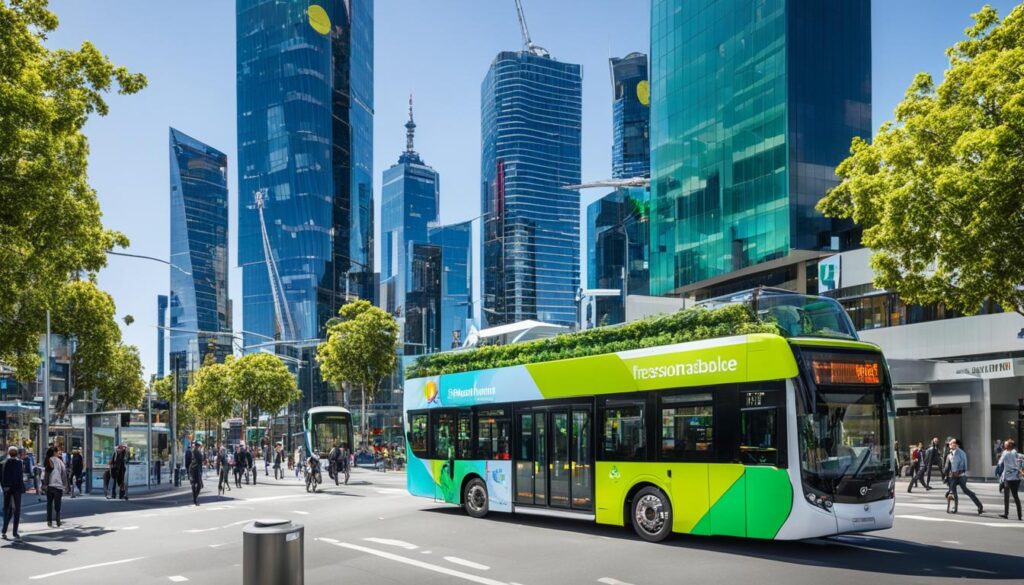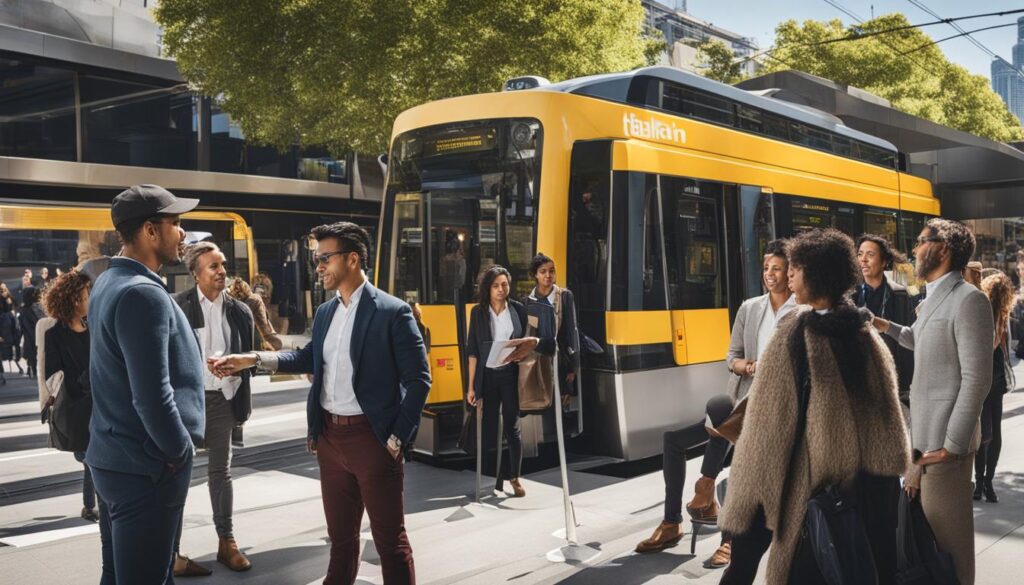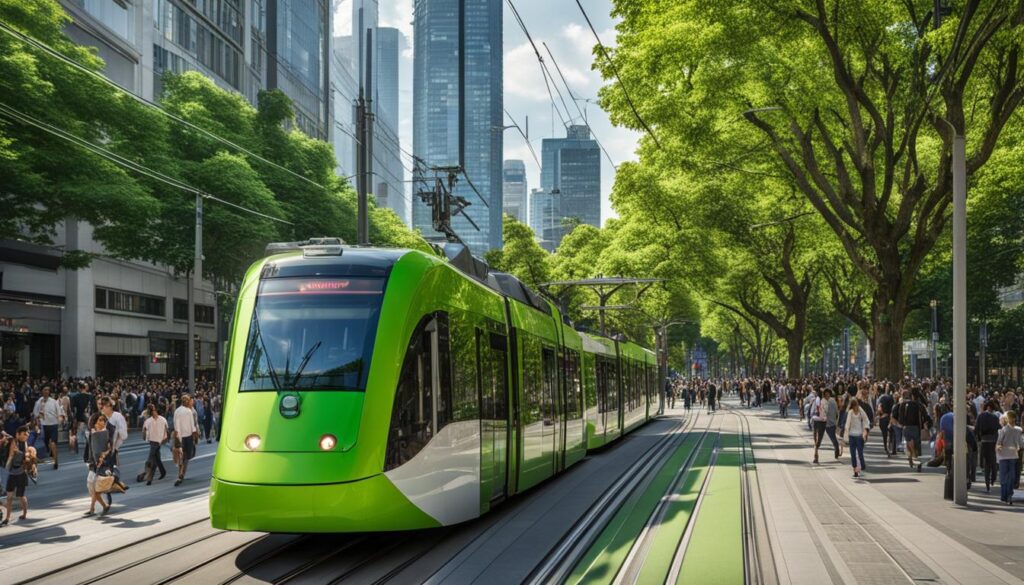Welcome to our article that delves into the evolution of Melbourne’s public transportation system from a sustainability perspective. As a city that has been growing rapidly in recent years, it is crucial to embrace eco-friendly practices and green initiatives when developing the public transport infrastructure. Melbourne’s public transport has come a long way, with the introduction of innovative technology, renewable energy, and community engagement in promoting sustainable transportation choices.
In this article, we will explore the history of Melbourne’s public transport system, the challenges faced and how they were overcome, and the green initiatives that are driving sustainable transportation forward. We will also examine the role of technology, public policy, and community engagement in advancing sustainable development goals in the public transport sector.
Key Takeaways
- Sustainability is critical to the development of Melbourne’s public transportation system.
- Eco-friendly practices and green initiatives are vital in enhancing sustainability in the transport sector.
- The implementation of renewable energy technologies and smart transportation systems can reduce the city’s carbon footprint.
- Community engagement and public policy play crucial roles in driving sustainable development goals in transport.
- Sustainable development goals in the public transport sector can mitigate climate change and promote environmental conservation.
Understanding Sustainability in Transportation
At its core, sustainability in transportation refers to the practice of promoting and maintaining a balance between social, economic, and environmental factors while providing efficient and safe transport options.
As a component of sustainable living, reducing carbon footprint is a critical aspect of sustainable transportation. This can be achieved by encouraging responsible consumption habits and embracing eco-friendly transportation options such as walking, cycling, and the use of public transport. Such measures help to reduce greenhouse gas emissions and improve air quality, which is crucial to environmental conservation and mitigating climate change.
But sustainability in transportation goes beyond just reducing carbon footprint and embracing green transport options. It also involves ensuring equitable access to transportation services and infrastructure to promote social inclusion and support economic growth. Moreover, promoting safety, efficiency, and convenience in transportation has a positive impact on productivity.
In summary, embracing sustainable transportation practices is essential to achieving sustainable living, environmental conservation, responsible consumption, and inclusive economic development in Melbourne.
Melbourne’s Early Transportation System
When Melbourne’s public transportation system was first established, it consisted mainly of horse-drawn carriages and trams. In 1884, the city welcomed its first electric tramway system, which quickly grew in popularity due to its efficiency and reliability. However, the early transportation system had limited focus on eco-friendliness and sustainability.
Many of the early transportation methods relied on non-renewable resources, such as coal and oil, which contributed greatly to carbon emissions and pollution. This lack of focus on sustainable development led to long-term environmental consequences that are still being felt today.
Despite this, Melbourne’s transportation system gradually evolved over the years, incorporating more sustainable practices as awareness of environmental issues grew. With this focus on sustainable development, the city has made significant strides in recent years to promote eco-friendly transportation options and reduce its carbon footprint.
Challenges Faced by Melbourne’s Transportation System
As Melbourne continues to grow, its transportation system faces numerous challenges, particularly with regards to sustainability and eco-friendliness. One of the primary concerns is the city’s reliance on private vehicles, which contribute significantly to carbon emissions and traffic congestion. This not only impacts the environment but also affects the quality of life for residents and visitors alike.
Another challenge is the lack of infrastructure and resources dedicated to sustainable transportation options. While there have been efforts to introduce measures such as bike lanes and public transport services, there is still room for improvement in terms of accessibility, affordability, and convenience.
Moreover, implementing eco-friendly practices in the public transport sector requires significant investment and planning, which can be difficult to achieve without proper government support and policy frameworks. There is also a need for public education and awareness campaigns to encourage more sustainable transportation choices among the community.
Despite these challenges, there is hope for Melbourne’s transportation system to become more sustainable and eco-friendly. By addressing the barriers and investing in innovative solutions, we can promote a cleaner and more efficient public transport system. This not only benefits the environment but also contributes to a healthier, happier, and more vibrant community.
Green Initiatives in Melbourne’s Public Transportation
Melbourne’s public transport system has become increasingly eco-conscious in recent years. The city has implemented a range of green initiatives to reduce its carbon footprint and enhance sustainability. One key focus has been on the use of renewable energy sources to power public transportation.

The city has installed solar panels on trams and trains, allowing them to harness energy from the sun. This has significantly reduced greenhouse gas emissions and energy consumption. Additionally, hybrid and electric buses have been introduced to reduce reliance on fossil fuels.
Other Eco-Friendly Practices
Beyond renewable energy, Melbourne’s public transport system has adopted other eco-friendly practices to promote sustainability. These include:
- Using low-carbon concrete for tram tracks and railway sleepers
- Encouraging the use of bicycles and walking paths for short journeys
- Installing energy-efficient lighting and ventilation systems in stations and depots
The Benefits of Green Initiatives in Public Transport
Implementing green initiatives in Melbourne’s public transportation system has numerous benefits for the city and its residents. First and foremost, it reduces the negative impact on the environment by reducing carbon emissions and energy consumption. Additionally, it promotes sustainable living and contributes to the city’s goal of becoming carbon neutral by 2050.
“Melbourne’s public transport system is leading the way in sustainable transportation, setting an example for other cities around the world to follow.”
Ultimately, these green initiatives will have long-lasting positive effects on Melbourne’s public transport system and the environment as a whole.
The Role of Technology in Sustainable Transportation
As we continue to strive towards making Melbourne’s public transport system more sustainable, technology plays a crucial role in achieving this goal. The harnessing of renewable energy sources and the implementation of smart transportation systems can lead to the reduction of the city’s carbon footprint. The use of electric buses and trains, powered by renewable energy sources such as solar power can significantly reduce the carbon emissions from traditional transportation systems.
In addition, the integration of smart transportation systems can effectively reduce traffic congestion and increase the efficiency of public transport. With the help of real-time data analytics, we can predict and manage traffic, improve routes, and reduce idle times at stops.
There is also promising research being conducted on the use of self-driving vehicles in public transport. These vehicles are programmed to operate safely and efficiently and have the potential to reduce traffic congestion while providing riders with a reliable and eco-friendly mode of transportation.
| Technology | Benefits |
|---|---|
| Renewable energy sources | Reduces carbon emissions |
| Smart transportation systems | Increases efficiency and reduces traffic congestion |
| Self-driving vehicles | Improves safety and reliability |
It is essential that we continue to embrace the role of technology in achieving sustainable transportation while ensuring these advancements align with environmental sustainability goals.
Community Engagement in Sustainable Transportation
At the heart of sustainable transportation lies community engagement. When the public is involved and invested in promoting environmentally friendly transportation practices, it creates a culture of responsibility and accountability.
Melbourne has implemented a range of initiatives that encourage community involvement in sustainable transportation. The city’s public transport services have actively solicited feedback from the public, using the information provided to develop transportation options that meet the needs of the community.

Community-Based Programs
In addition to feedback mechanisms, there are several community-based programs that promote sustainable transportation. For example, the “Riding to Learning” program encourages children to cycle to school. The initiative educates children about bike safety, introducing them to sustainable transportation choices from a young age.
The Car Pooling program is another initiative that promotes community engagement. By encouraging ride-sharing, the program reduces the number of cars on the road, easing traffic congestion while reducing greenhouse gas emissions.
Education and Awareness
Education and awareness initiatives are essential for community engagement. The city of Melbourne has introduced several programs that educate the public about sustainable transportation options, ranging from public service announcements to road safety campaigns.
The “Choose the Right Tool” campaign educates the public about different transportation options’ environmental impact. This program provides information on different modes of transportation, highlighting the environmental impact of each option and encouraging the public to select eco-friendly choices wherever possible.
Impact of Community Engagement in Sustainable Transportation
Community engagement plays a critical role in promoting sustainable transportation options. By involving the public, it creates a sense of ownership and investment in eco-friendly choices, encouraging the use of public transport, walking, biking, or carpooling.
Community engagement initiatives have significantly contributed to Melbourne’s public transport sustainability goals. As the city continues to develop eco-friendly transportation options, community engagement will remain an essential component of the sustainability strategy.
Public Policy and Sustainable Transportation in Melbourne
In our previous sections, we examined the evolution of Melbourne’s public transportation system and the various initiatives taken towards sustainability. In this section, we focus on the role of public policy in driving eco-friendly practices in the public transport sector.
The Government of Victoria has taken several measures to promote sustainable transportation in Melbourne. One of the significant initiatives is the ‘Victorian Renewable Energy Target’ (VRET), which aims to source 50% of Victoria’s electricity from renewable energy by 2030. This has resulted in a significant increase in investment in renewable energy sources, such as wind and solar, for powering public transportation.
The government has introduced other green initiatives, such as the ‘Zero Emissions Bus Trial’ and ‘New Energy Bus Scheme’, to replace conventional buses with zero-emissions electric buses. This measure has helped reduce greenhouse gas emissions and improve air quality.
“The integration of renewable energy solutions and smart transportation systems have helped Melbourne reduce carbon emissions, mitigate climate change, and promote sustainable development goals.”
The government has also implemented regulations to encourage the adoption of sustainable practices in the transportation sector. For instance, the ‘Commercial Passenger Vehicle Industry Act 2017’ encourages commercial vehicle providers to prioritize eco-friendly vehicles by offering incentives such as reduced registration fees for hybrid vehicles or vehicles powered by alternative fuels.
Furthermore, the government has increased funding towards the electric vehicle sector, contributing to the development of electric vehicle infrastructure, such as charging stations, and tax incentives to promote the purchase of electric vehicles. This has led to a significant increase in the adoption of electric vehicles in Melbourne.
In conclusion, Melbourne’s public transportation system has seen significant advancements towards sustainability, driven by both green initiatives and public policy. The government’s strategic planning and regulations have helped pave the way for a more environmentally friendly transportation sector, reducing carbon emissions and improving air quality. We can only hope that these measures continue and become the norm nationwide.”
Impacts of Sustainable Transportation on Melbourne’s Environment
We cannot underestimate the positive impacts of sustainable transportation on Melbourne’s environment. It is evident that eco-friendly public transportation choices play a critical role in contributing to environmental conservation and mitigating climate change. Such practices are fundamental to preserving our ecosystem for a sustainable future.
Through sustainable transportation, we can significantly reduce carbon emissions, which pollute the air and lead to climate change. By embracing sustainable transportation practices, we can curtail the number of cars on the road, reducing the amount of non-renewable energy consumed, consequently decreasing our carbon footprint.
In addition, sustainable transportation through Melbourne’s public transport system reduces congestion, enhances accessibility, and improves the quality of life for the community. It helps in reducing noise pollution by cutting down on traffic on the roads furthermore making Melbourne more livable.
| Sustainable Transportation Benefits | Effects on Environment |
|---|---|
| Reduces Carbon Emissions | Prevents Pollution and mitigates climate change |
| Reduces Congestion | Lowers traffic jams, noise pollution |
| Improves the Quality of Life | Livability improvement and more sustainable future |
It is encouraging to note that Melbourne has embraced sustainable transportation practices and green initiatives through its public transport system to benefit not only our environment but also the community as a whole.

Public transportation, combined with sustainable transportation practices, is essential to protect Melbourne’s public health, preserve our ecosystems, and achieve sustainable development goals. By embracing sustainable transportation, we safeguard our environment for future generations.
Future Prospects for Sustainable Transportation in Melbourne
As we continue to prioritize sustainability and eco-friendly practices in Melbourne’s public transportation system, the future looks promising. We can expect to see advancements in renewable energy sources and smart transportation systems that minimize carbon footprint and promote sustainable development.
One such initiative is the proposed expansion of Melbourne’s tram network, which is set to extend to several new locations across the city. This expansion will not only provide more sustainable transportation options but also generate more jobs in the public transportation sector.
In addition, the city plans to introduce electric buses powered by renewable energy, reducing emissions and improving air quality. These buses will also enhance passenger comfort and provide a more efficient transportation service for commuters.
Further developments in sustainable transportation could also help Melbourne achieve its climate change goals. The city aims to reduce greenhouse gas emissions by 28% by 2020, and these initiatives in public transportation will play a significant role in achieving this target.
It is evident that Melbourne’s commitment to sustainability and eco-friendly practices in public transportation will lead to a greener, more efficient, and sustainable future for the city and its residents.
Conclusion
Throughout this article, we have explored the evolution of Melbourne’s public transportation system from a sustainability perspective. We have seen how eco-friendly practices and green initiatives have played a significant role in enhancing the city’s public transport system.
We have discussed the concept of sustainability in transportation and its importance in promoting sustainable living, environmental conservation, and responsible consumption. We also explored the early transportation system in Melbourne and its impact on sustainable development in the city.
However, we have also noted the challenges faced by Melbourne’s transportation system, specifically in the context of sustainability. It is clear that there is a need to adopt more eco-friendly practices and overcome barriers to sustainable transportation.
Thankfully, we have highlighted several green initiatives implemented in Melbourne’s public transport system, including the use of renewable energy sources and smart transportation systems. These initiatives have contributed to reducing the city’s carbon footprint and promoting sustainable development.
Of course, community engagement remains a critical aspect of promoting sustainable transportation. We have seen how initiatives that involve the community and encourage responsible transportation choices can have a positive impact.
Public policy has also played a critical role in driving sustainable transportation in Melbourne. Government initiatives and regulations have helped to promote eco-friendly practices and green initiatives in the public transport sector.
Ultimately, we have seen how sustainable transportation has a positive impact on Melbourne’s environment, contributing to environmental conservation and mitigating climate change.
Looking to the future, there is great potential for further advancements and initiatives that could enhance Melbourne’s public transport system further. As we continue to strive towards a more sustainable future, it is crucial to keep sustainability, eco-friendly practices, and green initiatives at the forefront of our efforts.
FAQ
What are some eco-friendly practices in sustainable transportation?
Eco-friendly practices in sustainable transportation include using public transport, cycling, walking, carpooling, and using electric vehicles. These practices help reduce carbon emissions and promote environmental conservation.
How does sustainable transportation contribute to environmental conservation?
Sustainable transportation reduces carbon emissions and promotes the use of renewable energy sources, leading to a lower carbon footprint. This helps mitigate climate change and preserves the environment for future generations.
What are green initiatives in Melbourne’s public transportation system?
Green initiatives in Melbourne’s public transportation system include the use of renewable energy sources, implementing energy-efficient technologies, and promoting responsible consumption. These initiatives aim to improve the environmental sustainability of the transport system.
How can the community engage in sustainable transportation practices?
The community can engage in sustainable transportation practices by using public transport, cycling, or walking instead of driving, participating in carpooling programs, and advocating for improved infrastructure and policies that support eco-friendly transportation choices.
What role does technology play in sustainable transportation?
Technology plays a crucial role in sustainable transportation by enabling the integration of renewable energy solutions, developing smart transportation systems, and providing real-time information to promote efficient and environmentally friendly travel options.
What are the impacts of sustainable transportation on Melbourne’s environment?
Sustainable transportation in Melbourne has positive impacts on the environment, including reduced air pollution, improved air quality, and reduced greenhouse gas emissions. It also helps protect natural habitats and supports the overall environmental conservation efforts in the city.
What is the future outlook for sustainable transportation in Melbourne?
The future of sustainable transportation in Melbourne looks promising, with advancements in renewable energy technologies, the development of efficient public transport systems, and the increasing adoption of electric vehicles. Continued efforts and initiatives are expected to further enhance the city’s public transport system and contribute to sustainable development goals.
